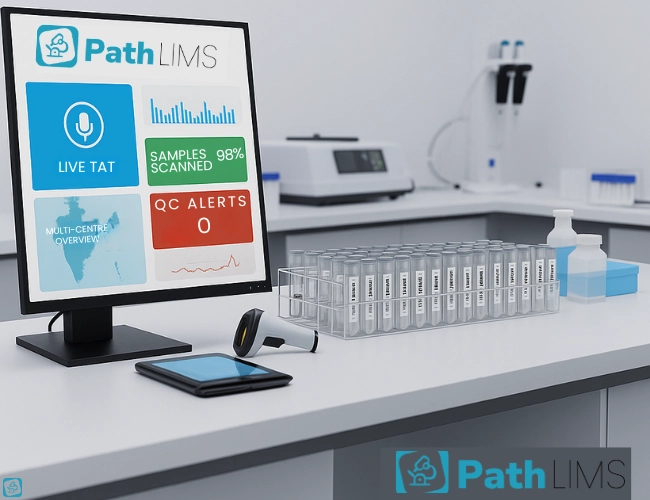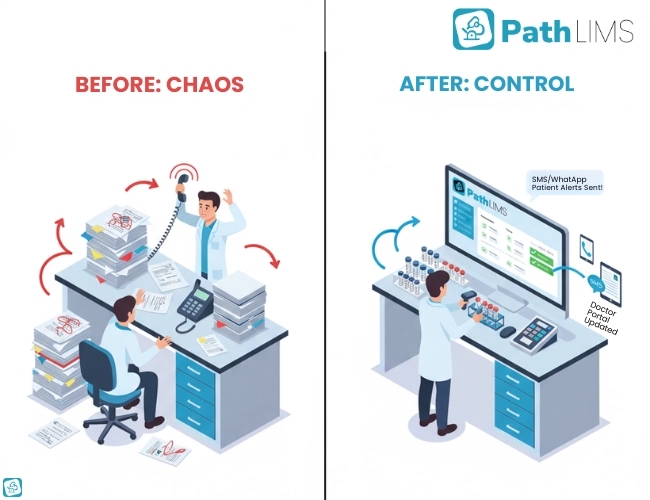Healthcare is one of those highly sensitive spaces where even a missed punctuation mark can result in life or death situation.
And who else can better understand this but the diagnostics laboratories handling vital patient data and disease test reports?
Unfortunately, Indian labs lose average ₹3 lakhs/year due to various manual errors like misplaced samples, wrong spellings, data entry typos. The burden is greater than just money. Errorneous information can cost your lab its reputatoion and even lead to losing its license.
But your lab can COMPLETETLY avoid all these mistakes!
Let us dig in those very common lab mistakes you should be aware of and how to fix them for once and all.

Key Takeaways
- Most delays aren’t on the analyser—they’re in the hand-offs. Fix the pre-/post-analytical leaks (labels, data entry, paperwork, notifications) and overall TAT improves fast without hiring.
- Standardise the routine to eliminate rework. Barcode accessioning, digital requisitions, and bi-directional analyser interfaces cut typos, lost records, and mismatched tests—the silent money drains.
- Give everyone live visibility. Real-time dashboards, portals, and audit-ready logs keep owners, doctors, and patients informed—speeding decisions, smoothing audits (ISO 15189/NABL), and lifting trust.
10 Errors and How to Fix Them with a Smart LIMS
1. Mislabeled Sample Vials
Problem
A single swapped or poorly written label can trigger wrong results and force expensive re-tests. Labs lose both money and trust.
The Fix
Use a LIMS with barcode accessioning. This automates the link between a patient and their sample, eliminating manual errors from the start.
2. Data-Entry Mistakes
Problem
Manual typing is slow and error-prone. A missing digit in the MRN or a wrong test code means samples sit idle or are tested incorrectly.
The Fix
A bi-directional analyzer interface eliminates retyping. It links patient data directly to the instrument and auto-fills results back into the system.
3. Paperwork Drag
Problem
Stacks of forms, missing signatures, and unclear handwriting waste hours and add confusion. Audits become nightmares when key papers go missing.
The Fix
Switch to digital requisitions and reports. This cuts down on paperwork, centralizes all key documents, and makes audits a breeze.
4. Lost Patient Records
Problem
Misplaced files don’t just derail audits—they can directly impact continuity of care when previous reports aren’t traceable.
The Fix
A LIMS creates a searchable digital repository. Every report and record is securely stored and instantly accessible.
5. Delays to Referring Doctors
Problem
When doctors wait for reports or call for updates, perceived TAT looks worse than it actually is. Frustrated clinicians may stop sending work your way.
The Fix
A dedicated doctor portal and auto-alerts keep clinicians informed in real time. They can view results as soon as they’re ready, without having to call.
6. Slow Patient Notifications
Problem
Patients expect results quickly, often via SMS or WhatsApp. Relying on manual calls or physical pickup adds delay and frustration.
The Fix
Set up automated SMS/WhatsApp notifications. Patients receive a secure link to their report the moment it’s finalized.
7. Chaotic Multi-Centre Operations
Problem
Labs running multiple centres struggle with reconciling samples, manifests, and reports. Manual reconciliation often leads to mismatched records.
The Fix
Use a LIMS with unified dashboards. This gives you a single, real-time view of all operations across every centre, from sample collection to report dispatch.
8. Training Time Drain
Problem
New staff spend weeks learning “tribal knowledge” instead of following clear, standardized workflows. This slows down productivity and increases errors.
The Fix
Guided workflows with built-in QC checks compress training time. A new hire can become productive much faster, with fewer mistakes.
9. No Centralized Control
Problem
Owners and managers lack live visibility. They can’t see pending tests, QC status, or reagent use until problems spill over.
The Fix
Live control tiles give owners instant visibility into every aspect of their lab. You can see what’s happening, where, and why, all in real time.
10. Regulatory Gaps
Problem
Without proper audit trails and QC/QA documentation, labs scramble during ISO 15189 / NABL audits. Missing evidence means delays and extra scrutiny.
The Fix
A LIMS maintains immutable logs and QA modules. This simplifies NABL/ISO inspections by providing a complete, verifiable history of every test and action.
Helpful reference: Review NABL’s official accreditation framework and updates here → National Accreditation Board for Testing and Calibration Laboratories (NABL)
How an Intelligent LIMS Can Solve This
Here’s where a purpose‑built Laboratory Information Management System (LIMS) makes the difference:
- Barcode accessioning to prevent mislabels.
- Bi‑directional analyser interfacing to eliminate retyping.
- Digital requisitions and reports to cut paperwork drag.
- Searchable repositories to stop lost records.
- Portals and auto‑alerts to keep doctors and patients informed in real time.
- Unified dashboards for multi‑centre labs.
- Guided workflows to compress training time.
- Live control tiles to give owners instant visibility.
- Immutable logs and QA modules to simplify NABL/ISO audits.
Why PathLIMS Outperforms Generic LIMS in India

Before You Go
We built PathLIMS to help Indian labs reduce errors, improve turnaround time, and strengthen patient trust. With PathLIMS you get to enjoy:
- Unlimited patient records management (even on Free Forever plan)
- Unlimited test creation and customization
- Manage multiple centers
- Doctor and patient portals
- Online report sending
- And more
Want to explore how it fits into your lab?




